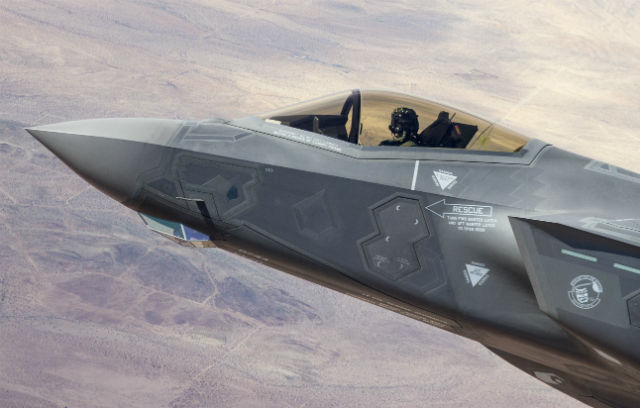On 18 July, without a formal ceremony and in a state of political turmoil, Italy launched assembly activities on its first Lockheed Martin F-35A combat aircraft.
The new, €800 million ($1 billion) final assembly and check-out (FACO) facility inside Cameri air base, near Milan "was established in a compressed period and is running on schedule and budget," General Chief Inspector Domenico Esposito, head of Aeronautics Armament Procurement, said in a recent interview released by the Italian defence ministry.
 |
|---|
Italian defence ministry |
Despite the value of Italy's industrial commitment to the F-35, government and political representatives did not attend the opening event. This situation was prompted by two recent parliamentary votes against the programme, which saw the split ruling majority approve a motion which will require parliament to vote for any further purchases of the aircraft.
Italy currently plans to acquire 60 conventional take-off and landing (CTOL) F-35As and 15 short take-off and vertical landing (STOVL) F-35Bs for its air force, plus 15 more of the latter for the navy to employ from its Cavour aircraft carrier.
The combined total represents a challenge for the Italian government and an industrial team that includes Alenia Aermacchi and Lockheed, as the FACO has been established assuming national investments to assemble at least 131 F-35A/Bs for Italy and 85 A-model examples for the Netherlands, which could now potentially buy as few as 55. Nonetheless, Esposito says: "We hope to reach 200 units, with other potential sales in the European-Mediterranean region."
 |
|---|
Lockheed Martin Rome expects to buy 60 of its planned 90 F-35s in the CTOL configuration |
However, the main investment return is expected to come from future F-35 support activities for regional operators, also including the US military, with Lockheed indicating the Italian FACO as being the logical maintenance, repair, overhaul and upgrade (MRO&U) centre of excellence for the European and Mediterranean region.
"With the aircraft assembly reaching its regime, the FACO will gradually evolve into a MRO&U facility for the estimated potential 600 F-35s operating in the same region and other customers," Esposito says. "We already signed an agreement with the Netherlands for assembling their F-35s, while they will support our aircraft's [Pratt & Whitney F135] engines. A similar agreement in the aircraft logistic support area has been signed with Norwegian authorities for their planned F-35 acquisition."
According to Esposito, the work performed at the FACO and elsewhere in Italy should sustain at least 6,000 jobs, while "allowing in parallel the relinquishing of F-35 technology to national industry". Rome had previously cited a figure of 10,000 linked to a 131-aircraft buy.
Cameri air base already accommodates Italy's repair and overhaul hub for the Eurofighter and Panavia Tornado. The secure FACO compound hosts the assembly and check-out line for both CTOL and STOVL variant aircraft, as well as Alenia Aermacchi-managed assembly facilities for F-35 full-wing sets.
With FACO delivery capability of two aircraft per month, the wing component production, lasting from 2011 in initially temporary facilities for early Lot 5 and 6 to speed the learning curve, can reach up to six full sets per month. The full-wing set components arrive in Cameri from other Alenia Aermacchi facilities and national small-to-medium enterprises.
"The 131 aircraft reduction to 90 lowered the overall programme costs to €14.3 billion, of which €2.1 billion is already spent," Esposito says. While the defence ministry has not provided a split for the total cost, it is believed to include €800 million for development, about €7.5 billion for aircraft acquisition, €3.3 billion for support, logistical equipment, infrastructure and base upgrades, and modifications required for the Cavour, plus around €1.7 billion for initial logistics support services until 2027.
Italy has so far seen a return on its investment worth €800 million, and Esposito says its overall benefit is estimated as eventually totalling $14.7 billion, or roughly 76% of its development and production phase costs, before considering MRO&U activities.
The majority of the return will come through Alenia Aermacchi, which has already received contracts worth a combined $141 million linked to the F-35's sixth and seventh low-rate initial production (LRIP) orders. In all, the Finmeccanica company's stake through LRIP 11 production is estimated at $1.2 billion, largely related to non-Italian aircraft.
"Around 30 small-to-medium enterprises are also involved in the programme, while others are expected to join, increasing the overall technology level for Italian industries fabric," Esposito says. However, he notes that the national reduction from 131 to 90 aircraft has seen Alenia Aermacchi's overall production plan reduced from about 1,200 to 800 wing-sets for the F-35.
Italy has so far confirmed orders for three F-35As each in LRIP 6 and 7, and provided initial funding for four more in Lot 8. The defence ministry is also believed to have advanced funds for three F-35As and a first F-35B for the navy as part of LRIP 9.
However, analysis is continuing to evaluate the possible impact of postponing acquisitions toward full-rate production lots, and even further cuts, versus the nation's agreed investment returns.
Source: Flight International



















